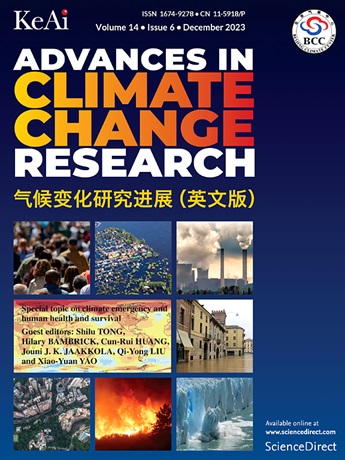1950 - 2022年东北地区地表冻结过程的破碎化
IF 5.2
1区 地球科学
Q1 ENVIRONMENTAL SCIENCES
引用次数: 0
摘要
目前的研究主要采用冻结开始和结束日期、冻结持续时间和冻结深度来描述冻结状态,往往忽略了冻结过程的不连续性。利用1950 - 2022年的ERA5-Land再分析数据,系统分析了东北地区地表冻结过程的动态特征,并采用了新的碎片化视角。ERA5-Land数据集获得的地表(0 ~ 7 cm深度)温度与NEC的观测值(5 cm深度)相比,在探测冰冻日方面表现良好。从1950年到2022年,NEC的冻结过程变得越来越分散,冻结中断的次数以每十年0.04次的速度增加(p <;0.05),冻结破碎度以每10年每100 d 0.07次的速率上升(p <;0.01)。冻结过程破碎化的时空变化也存在区域差异。进一步分析表明,显著增加(p <;冻融循环事件数和冻融日数(- 1.8 d / 10年;p & lt;0.01)可能部分增加冻结过程破碎的概率。冻裂程度与空气温度和皮肤温度呈显著正相关(p <;0.01),与积雪时数、土壤体积水分呈极显著负相关(p <;0.05)。本文章由计算机程序翻译,如有差异,请以英文原文为准。
Fragmentation of ground surface freezing processes in Northeast China from 1950 to 2022
Current studies mainly employ the onset and end dates of freezing, freeze duration and freeze depth to describe the freeze state, often overlooking the discontinuous nature of the freezing process. In this study, the dynamics of the ground surface freezing processes in Northeast China (NEC) was systematically analysed using ERA5-Land reanalysis datasets from 1950 to 2022, and a new and fragmentation-focused perspective was adopted. The ground surface (0−7 cm in depth) temperature obtained from the ERA5-Land dataset performed well in detecting freeze days when compared with the observations (5 cm in depth) in NEC. From 1950 to 2022, the freezing processes in NEC became increasingly fragmented, with the number of freeze interruptions increasing at a rate of 0.04 times per decade (p < 0.05) and the freeze fragmentation degree rising at a rate of 0.07 times per 100 d per decade (p < 0.01). Regional differences in the spatial and temporal variations of the freezing process fragmentation were also detected. Further analysis suggested that a significant increase (p < 0.05) in the number of freeze–thaw cycle events and thaw days within the shortened freeze period (−1.8 d per decade; p < 0.01) may partially increase the probability of freezing process fragmentation. Moreover, the freeze fragmentation degree was positively and significantly correlated with air and skin temperatures (p < 0.01), while it was negatively and significantly correlated with snow cover duration and volumetric soil moisture (p < 0.05).
求助全文
通过发布文献求助,成功后即可免费获取论文全文。
去求助
来源期刊

Advances in Climate Change Research
Earth and Planetary Sciences-Atmospheric Science
CiteScore
9.80
自引率
4.10%
发文量
424
审稿时长
107 days
期刊介绍:
Advances in Climate Change Research publishes scientific research and analyses on climate change and the interactions of climate change with society. This journal encompasses basic science and economic, social, and policy research, including studies on mitigation and adaptation to climate change.
Advances in Climate Change Research attempts to promote research in climate change and provide an impetus for the application of research achievements in numerous aspects, such as socioeconomic sustainable development, responses to the adaptation and mitigation of climate change, diplomatic negotiations of climate and environment policies, and the protection and exploitation of natural resources.
 求助内容:
求助内容: 应助结果提醒方式:
应助结果提醒方式:


